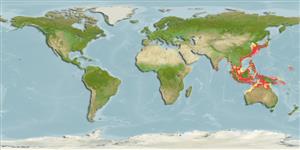>
Eupercaria/misc (Various families in series Eupercaria) >
Sparidae (Porgies)
Etymology: Argyrops: Greek, argyros = silver, silvered + Gree, ops = appearance (Ref. 45335).
Environment: milieu / climate zone / depth range / distribution range
Ökologie
seewasser; brackwasser demersal; tiefenbereich 50 - 200 m (Ref. 124569). Tropical
Western Pacific: Japan to Australia.
Size / Gewicht / Alter
Maturity: Lm ? range ? - ? cm
Max length : 50.0 cm SL Männchen/unbestimmt; (Ref. 124569); common length : 30.0 cm SL Männchen/unbestimmt; (Ref. 124569)
Rückenflossenstacheln (insgesamt): 10 - 11; Rückenflossenweichstrahlen (insgesamt): 9-11; Afterflossenstacheln 3; Afterflossenweichstrahlen: 8 - 9. This species is distinguished from all its congeners by the following set of characters: body deep and compressed; D XI,10 (rarely X,11); first dorsal-fin spine rudimentary (one dorsal-fin spine on first dorsal pterygiophore), the second to sixth spines (usually 5, rarely 4) are much elongated and flattened in juveniles 15-25 cm SL (second spine often reaching beyond level of last dorsal soft rays, shorter and reaching first soft dorsal-fin ray base in specimens of ca. 30 cm SL); orbit diameter clearly less than suborbital depth; pupil diameter greater than preorbital length in specimens less than 20 cm SL, but pupil diameter is clearly less than preorbital length (more noticeable in specimens greater than approx. 30 cm SL; the rear margin of upper jaw extends to a vertical beyond orbit diameter; body bars reddish, often present to 25 cm SL; all fins reddish hyaline (Ref. 124569).
Inhabits sandy and muddy bottoms (Ref. 41299). Important food fish. In Okinawa (Japan), according to local fishermen, this species usually reches more thatn 50 cm SL and a buyer from Ryukyu Is. reported that some individuals occasionally attain 65 cm SL (Ref. 124569).
Life cycle and mating behavior
Geschlechtsreife | Fortpflanzung | Ablaichen | Eier | Fecundity | Larven
Iwatsuki, Y. and P.C. Heemstra, 2018. Taxonomic review of the genus Argyrops (Perciformes; Sparidae) with three new species from the Indo-West Pacific. Zootaxa 4438(3):401-442. (Ref. 124569)
IUCN Rote Liste Status (Ref. 130435)
Bedrohung für Menschen
Harmless
Nutzung durch Menschen
Fischereien: kommerziell
Mehr Information
NamenSynonymeMetabolismusRäuberÖkotoxikologieFortpflanzungGeschlechtsreifeAblaichenSpawning aggregationFecundityEierEientwicklung
ReferenzenAquakulturAquakultur ProfilZuchtlinienGenetikElectrophoresesVererbbarkeitKrankheitenVerarbeitungNutrientsMass conversion
PartnerBilderStamps, Coins Misc.LauteCiguateraGeschwindigkeitSchwimmstilKiemenoberflächeOtolithsGehirngrößeSehfähigkeit
Tools
Zusatzinformationen
Download XML
Internet Quellen
Estimates based on models
Preferred temperature (Ref.
123201): 17.4 - 28.2, mean 26.4 °C (based on 780 cells).
Phylogenetic diversity index (Ref.
82804): PD
50 = 0.5625 [Uniqueness, from 0.5 = low to 2.0 = high].
Bayesian length-weight: a=0.02089 (0.00974 - 0.04480), b=2.97 (2.80 - 3.14), in cm total length, based on LWR estimates for this (Sub)family-body shape (Ref.
93245).
Trophic level (Ref.
69278): 4.5 ±0.8 se; based on diet studies.
Widerstandsfähigkeit (Ref.
120179): niedrig, Verdopplung der Population dauert 4,5 - 14 Jahre. (Preliminary K or Fecundity.).
Fishing Vulnerability (Ref.
59153): Moderate vulnerability (44 of 100).
